Navigation
Install the app
How to install the app on iOS
Follow along with the video below to see how to install our site as a web app on your home screen.
Note: This feature may not be available in some browsers.
More options
Style variation
You are using an out of date browser. It may not display this or other websites correctly.
You should upgrade or use an alternative browser.
You should upgrade or use an alternative browser.
.223, 6mm, and 6.5 failures on big game
- Thread starter Dave0317
- Start date
deerhunter628
WKR
Oh boy. This thread has taken a wrong turn. All of the sudden i miss all the trivial arguing.
Last edited:
I'm surprised it took 35 pages to get to this point.Oh boy. This thread has taken a wring turn. All of the sudden i miss all the trivial arguing.
Time to refocus on the topic
Sent from my SM-S926U using Tapatalk
Sent from my SM-S926U using Tapatalk
Ucsdryder
Modern Fuddster
- Joined
- Jan 24, 2015
- Messages
- 7,548
Sorry…Time to refocus on the topic
Sent from my SM-S926U using Tapatalk
Small calibers suck.
Better?
The Fish Box
Lil-Rokslider
- Joined
- Aug 31, 2020
- Messages
- 187
Animals are just like people, one guy can take a complete beating and still keep swinging and the next guy has a glass jaw.
I have argued this shit with form before, back when I was a manly magnum only guy. I’ve had a few poor experiences with a 6.5 shooting copper bullets. Jumped back up to a 300 win mag which at distance with copper bullets sucked harder than pharmseller, but then shooting my 338 lapua with 300 grain Berger’s had some bang flops(not thru the spine) but also shot a forked horn buck at 120 yards thru the almighty shoulder only to have it run off over a 100 yards. The offside shoulder was only holding on by hide.
All that is to say I don’t think it matters what you shoot really but if shooting a big dog 338 works go for it, if a 22 creed works good for you. Unfortunately we form our opinions on the experiences we have and when you have a bad experience shooting a small gun it’s easy to say if I had a bigger gun it would have been better, but maybe you had the one in a million experience only to right the whole option off.
I have argued this shit with form before, back when I was a manly magnum only guy. I’ve had a few poor experiences with a 6.5 shooting copper bullets. Jumped back up to a 300 win mag which at distance with copper bullets sucked harder than pharmseller, but then shooting my 338 lapua with 300 grain Berger’s had some bang flops(not thru the spine) but also shot a forked horn buck at 120 yards thru the almighty shoulder only to have it run off over a 100 yards. The offside shoulder was only holding on by hide.
All that is to say I don’t think it matters what you shoot really but if shooting a big dog 338 works go for it, if a 22 creed works good for you. Unfortunately we form our opinions on the experiences we have and when you have a bad experience shooting a small gun it’s easy to say if I had a bigger gun it would have been better, but maybe you had the one in a million experience only to right the whole option off.
Pharmseller
WKR
Jumped back up to a 300 win mag which at distance with copper bullets sucked harder than pharmseller,
You say that like it’s a bad thing.
Rules and all, I’ve never shot anything with a 6.5.
P
Stickmark
Lil-Rokslider
- Joined
- Feb 5, 2023
- Messages
- 109
Hardest to kill deer for me:
30-30, probably 150 grain Fusions, iirc, moving shot at @20 yards, very small coues buck trotting along with a group. I can still see the damage on first shot, lower shoulder, and second shot into upper boiler plate still did not "lights out" completely that deer.
Another N=1 story, but all these other "stories" do help a man think a little.
As close as I shoot, I need to pick my bullets accordingly.
30-30, probably 150 grain Fusions, iirc, moving shot at @20 yards, very small coues buck trotting along with a group. I can still see the damage on first shot, lower shoulder, and second shot into upper boiler plate still did not "lights out" completely that deer.
Another N=1 story, but all these other "stories" do help a man think a little.
As close as I shoot, I need to pick my bullets accordingly.
Have you ever thought loading a spitzer bullet for your first shot? I always thought about loading a spitzer bullet first then round nose bullets to follow but sold my 30-30 before I ever tested it out.Hardest to kill deer for me:
30-30, probably 150 grain Fusions, iirc, moving shot at @20 yards, very small coues buck trotting along with a group. I can still see the damage on first shot, lower shoulder, and second shot into upper boiler plate still did not "lights out" completely that deer.
Another N=1 story, but all these other "stories" do help a man think a little.
As close as I shoot, I need to pick my bullets accordingly.
FCCDerek
Lil-Rokslider
I think a majority of what people perceive as bullet failures are bad hits at extreme angles. Or just plain bad shooting.So there are no bullet failures? It is either poor manufacturing, bad shot, or the wrong bullet was used? Is this just your opinion or is there data to support this?
Stickmark
Lil-Rokslider
- Joined
- Feb 5, 2023
- Messages
- 109
I felt the bullet(s) did their job. I shot the 2nd shot quickly. In context of this this thread, the big, uncontrollable variable is individual animal position, temperment?, etc...Some of you guys harvest more in one or two seasons than I have since I got back into this since 2008, rifle and stick bow. Good thread.Have you ever thought loading a spitzer bullet for your first shot? I always thought about loading a spitzer bullet first then round nose bullets to follow but sold my 30-30 before I ever tested it out.
(30-30 went bye bye, courtesy of the "Big D, and don't mean Dallas")
A LOT of truth to this...I think a majority of what people perceive as bullet failures are bad hits at extreme angles. Or just plain bad shooting.
I worked at the Ft Meade check-in station for two seasons in the 1990s. We signed hunters in and out to hunt the whitetails in the range impact areas - many acres of woods and swamps. The rules required hunters to be at the check-out (too) shortly after dark, so if you hit a deer just before dark, there often wasn't time to trail it up and get it out. The procedure was to come back to check-out and let us know you hit one, and a few of us would go back out with you, and trail up and help recover your deer. Great trailing practice and improved my understanding of wounded deer actions tremendously.
In spite of the shooting qualifications needed to hunt this federal property, (3 out of 5 shotgun slugs on a 9" paper plate at 50 yards, and/or 3 out of 5 arrows at 25 yards), we saw a lot of really bad shooting. When I worked the range for these qualifications, I was constantly amazed at how badly people can shoot and still think they can successfully deer hunt. Many needed multiple attempts to qualify.
Two or three evenings a week we would have someone come in to check-out and state that they had 'hit him perfectly' but failed to find the deer within 50 or 100 yards of the spot where the shot was taken. We would go back out with the hunter and search, sometimes for several hours. For every deer that actually was hit perfectly, we found 8 or 10 had been shot poorly. Almost invariably, those 'perfectly hit' deer were hit too high and/or too far back and some even shot in the hindquarters, yet the hunter swore they knew exactly where the animal was hit and it was 'definitely in the vitals...'.
FCCDerek
Lil-Rokslider
Yup, manufacturing tolerances are immensely tight for the most part. Are there bullets out there with potential defects in them? Sure, statistically speaking that's inevitable. Now, let's think of the odds of one of those actual defective bullets being fired into an animal rather than at paper, steel, stumps, rocks, etc. Probably pretty slim. Now again, let's think of how well your average shooter out there actually shoots. Again, what are the odds of that said defective bullet being fired into an animal and that shot being placed well, at a reasonable angle and moving at sufficient velocity to perform correctly. Again, narrows the margin of that happening by a lot. I'd say maybe one shot in 1,000,000 on an animal in a hunting scenario is an actual wonky bullet shot well at an animal and hitting it inside of its performance window. Now, what is the measure of bullet failure? No way of saying that conclusively. The only way I'd consider a bullet as having clinically failed is if it comes apart in the air due to gross manufacturing defects before it even hits the animal. I've never had that happen and I've fired hundreds of thousands of rounds between my personal shooting and shooting in the military. I've cull killed hundreds and hundreds of deer on bases and never saw a bullet fail on one of them. They all died.A LOT of truth to this...
I worked at the Ft Meade check-in station for two seasons in the 1990s. We signed hunters in and out to hunt the whitetails in the range impact areas - many acres of woods and swamps. The rules required hunters to be at the check-out (too) shortly after dark, so if you hit a deer just before dark, there often wasn't time to trail it up and get it out. The procedure was to come back to check-out and let us know you hit one, and a few of us would go back out with you, and trail up and help recover your deer. Great trailing practice and improved my understanding of wounded deer actions tremendously.
In spite of the shooting qualifications needed to hunt this federal property, (3 out of 5 shotgun slugs on a 9" paper plate at 50 yards, and/or 3 out of 5 arrows at 25 yards), we saw a lot of really bad shooting. When I worked the range for these qualifications, I was constantly amazed at how badly people can shoot and still think they can successfully deer hunt. Many needed multiple attempts to qualify.
Two or three evenings a week we would have someone come in to check-out and state that they had 'hit him perfectly' but failed to find the deer within 50 or 100 yards of the spot where the shot was taken. We would go back out with the hunter and search, sometimes for several hours. For every deer that actually was hit perfectly, we found 8 or 10 had been shot poorly. Almost invariably, those 'perfectly hit' deer were hit too high and/or too far back and some even shot in the hindquarters, yet the hunter swore they knew exactly where the animal was hit and it was 'definitely in the vitals...'.
omicron1792
WKR
- Joined
- Feb 20, 2024
- Messages
- 973
Pretty clear the bullet failure for most is the animal didn’t have the desired effect after being shot.
That said, I think that is a reasonable conversation. The argument for or against smaller calibers is not that the bullet has a failure in construction, it’s that the size of the bullet does not cause the desired effect on the target.
I personally believe small caliber bullets (the correct ones) cause plenty of damage and kill at a high rate.
However, the bar set by some here is unattainable. There is absolutely nothing that could be said, shown, etc that would make those with their heals dug in change their mind. It is kind of sad.
That said, I think that is a reasonable conversation. The argument for or against smaller calibers is not that the bullet has a failure in construction, it’s that the size of the bullet does not cause the desired effect on the target.
I personally believe small caliber bullets (the correct ones) cause plenty of damage and kill at a high rate.
However, the bar set by some here is unattainable. There is absolutely nothing that could be said, shown, etc that would make those with their heals dug in change their mind. It is kind of sad.
Axlrod
WKR
Maybe, but he is complaining about Rokslide on his 1509 th day here at, 1.43 posts per day. So it must not bad enough for him to leave...Best post here.
Sent from my iPhone using Tapatalk
deerhunter628
WKR
I would expect the small caliber crowd to attack you for saying you have shot hundreds of deer and killed them all and had no bullet failures. Come on Form. Oh wait. This one fits your narrative so it is probably true.Yup, manufacturing tolerances are immensely tight for the most part. Are there bullets out there with potential defects in them? Sure, statistically speaking that's inevitable. Now, let's think of the odds of one of those actual defective bullets being fired into an animal rather than at paper, steel, stumps, rocks, etc. Probably pretty slim. Now again, let's think of how well your average shooter out there actually shoots. Again, what are the odds of that said defective bullet being fired into an animal and that shot being placed well, at a reasonable angle and moving at sufficient velocity to perform correctly. Again, narrows the margin of that happening by a lot. I'd say maybe one shot in 1,000,000 on an animal in a hunting scenario is an actual wonky bullet shot well at an animal and hitting it inside of its performance window. Now, what is the measure of bullet failure? No way of saying that conclusively. The only way I'd consider a bullet as having clinically failed is if it comes apart in the air due to gross manufacturing defects before it even hits the animal. I've never had that happen and I've fired hundreds of thousands of rounds between my personal shooting and shooting in the military. I've cull killed hundreds and hundreds of deer on bases and never saw a bullet fail on one of them. They all died.
Well if you have no idea how far your bullet is being moved by the wind you shouldn't shoot. There are many charts but the trick is pegging wind velocity. I never said I could tell the wind inside of 1 mph. That airhead has a reading comprehension problem.Everyone on the internet is world class until they come out and actually shoot.
I think a shoot off is in order!!!Well if you have no idea how far your bullet is being moved by the wind you shouldn't shoot. There are many charts but the trick is pegging wind velocity. I never said I could tell the wind inside of 1 mph. That airhead has a reading comprehension problem.
I came to Rokslide as a new adult hunter who didn’t get the result expected on my first deer. Lots of energy, yet it ran a long way. Still dead and recovered. 35 whelen with a 150g bullet. Same bullet at 800fps slower worked better. This started my research into how does a bullet work and what bullets work best.
Now I don’t have that many successful harvests, 6 over 3 years, but I can wrap my head around what form and others have suggested as a possible better solution. Unfortunately I don’t get to use anything smaller than 35 cal so I can’t try the heavy for caliber target bullleta as they don’t exist in 35 cal. Nor would I want to use them as the recoil would be substantial.
I hope to have more data this year by shooting different bullets of the same caliber to see how they compare.
Now I don’t have that many successful harvests, 6 over 3 years, but I can wrap my head around what form and others have suggested as a possible better solution. Unfortunately I don’t get to use anything smaller than 35 cal so I can’t try the heavy for caliber target bullleta as they don’t exist in 35 cal. Nor would I want to use them as the recoil would be substantial.
I hope to have more data this year by shooting different bullets of the same caliber to see how they compare.
Choupique
WKR
- Joined
- Oct 2, 2022
- Messages
- 957
How about some wallop analysis?
.338 win
230gr norma oryx
85 yard shot
85 pounds
About 2700 fps impact
Deer ran about 80 yards.
Bullet went in starboard and exited port side
Big holes, tons of blood with chunks of rib and lung scattered around, 100% meat recovery including heart and liver. Lung soup inside of deer. I won't try to convince anybody a .338 is a good choice for anything, but it sure is fun. Great Wallop factor!
.375 h&h wallop study next!
All bs aside, this thing does work extremely well for meat blasting. Its completely ridiculous, which makes it fun, and the performance just so happens to be exactly what I want to see.
.338 win
230gr norma oryx
85 yard shot
85 pounds
About 2700 fps impact
Deer ran about 80 yards.
Bullet went in starboard and exited port side
Big holes, tons of blood with chunks of rib and lung scattered around, 100% meat recovery including heart and liver. Lung soup inside of deer. I won't try to convince anybody a .338 is a good choice for anything, but it sure is fun. Great Wallop factor!
.375 h&h wallop study next!
All bs aside, this thing does work extremely well for meat blasting. Its completely ridiculous, which makes it fun, and the performance just so happens to be exactly what I want to see.
Attachments
-
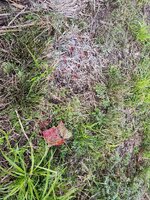 IMG_20241130_064851.jpg999.6 KB · Views: 83
IMG_20241130_064851.jpg999.6 KB · Views: 83 -
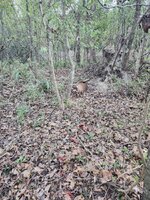 20241130_065034.jpg864.3 KB · Views: 85
20241130_065034.jpg864.3 KB · Views: 85 -
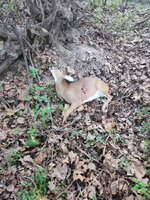 97530819-3dc1-4ec7-8aad-ea74b9a91a96.jpg762.3 KB · Views: 90
97530819-3dc1-4ec7-8aad-ea74b9a91a96.jpg762.3 KB · Views: 90 -
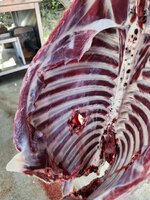 20241130_094238.jpg379.7 KB · Views: 89
20241130_094238.jpg379.7 KB · Views: 89 -
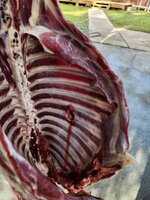 20241130_094243.jpg300.3 KB · Views: 85
20241130_094243.jpg300.3 KB · Views: 85 -
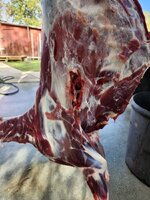 20241130_094251.jpg397.8 KB · Views: 81
20241130_094251.jpg397.8 KB · Views: 81 -
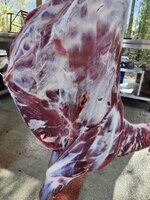 20241130_094234.jpg368.2 KB · Views: 84
20241130_094234.jpg368.2 KB · Views: 84
Similar threads
- Replies
- 264
- Views
- 26K
- Replies
- 2K
- Views
- 165K
Featured Video
Latest Articles
- TT#64 Josh Boyd Elk Hunting Strategies for Every Season
- Aaron Davidson of Gunwerks
- TT#63 Dirk Durham’s Art of Elk Calling
- BIG Buck Stories with the Dirty Giants Podcast
- TT#62 Brian Barney Hunting Bulls without Calling
- Hoyt Alpha AX-2 SD Review
- Kuiu Kenai vs Outdoor Vitals Vario Hooded Jacket Review
- Hoyt RX-9 Ultra Review
- Hunting Vampire Bucks & Building an Optics Kit
- Darton Sequel ST2 35 Review

